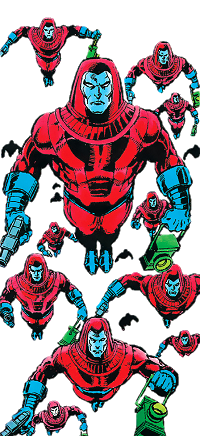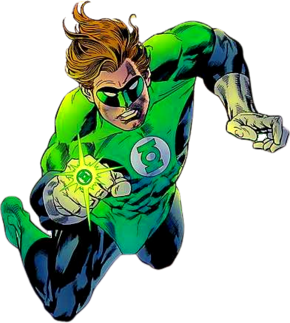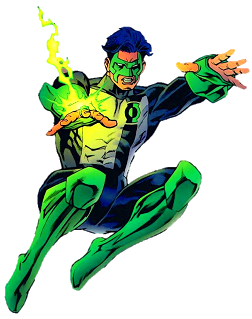Fictional character biography
G'nort is from the planet G'newt. Hal Jordan explains that G'nort became a Green Lantern due to the influence of his uncle, who was a famous member of the Lantern Corps. [2] Despite his obviously limited intelligence (not intelligent enough to read a map) and profoundly lacking tactical judgment, the character is consistently depicted as brave, loyal, and honorable. This fact is overlooked by most heroes, although Superman has pointed it out on occasion.
Early in his career, G'nort becomes inadvertently mixed up with the League's battle against the Manhunters. Recognizing G'Nort's general incompetence, the Corps had given him an uninhabited sector of space to patrol. The fact that the region was uninhabited also suited the needs of the Manhunters, who set up their home planet in G'Nort's sector. G'Nort joined Hal Jordan, Superman, and other Justice League members in an assault on the home world, although G'Nort's main contribution was getting stuck in the planet's ventilation system. [2]
Working with the League
G'nort's arch enemy, the Scarlet Skier (a take-off of Marvel's Silver Surfer), is described as being the only felon G'nort ever managed to apprehend in his entire career. Also an idiot, the Skier was mistaken for a pan-handling homeless person when traveling in the subway.
G'nort goes on a mission to rescue Mister Miracle from the interstellar trader Manga Khan. Traveling in a spaceship, G'nort works with Big Barda, Martian Manhunter, and Dmitri of the Rocket Reds. They chase down Khan and survive an assassination attempt by his hired killer Lobo. [5]
Both G'nort and the Skier were founding members of Justice League Antarctica, created by Maxwell Lord for the purpose of keeping both them and the reformed Injustice League out of his way.
The League, including G'nort, find their Antarctic headquarters overwhelmed by killer penguins. Their enemies are ultimately destroyed, but not before the facility itself gets demolished. G'Nort keeps himself and his new-found allies alive via his power-ring until help arrives. [6]
G'nort assists the League, this time consisting of Manhunter, Crimson Fox and Ice, when Mr. Nebula, the Skier's old boss, turns his dangerous, cosmic-powered attention to Earth. Mr. Nebula saw the garishness of Las Vegas and thought Earth had the same taste as he and thus left. [7]
G'nort sees himself as a "Green-Lantern-at-large", not bound to a single space sector. His most successful mission (apart from capturing the Skier) has been when a gang of interstellar bank-robbing humanoid cats surrender as soon as he appears.
Qward battle
Eventually it is discovered that both G'nort and his uncle G'newman were actually given their rings by the Poglachians, who posed as the Guardians of the Universe while the real Guardians were with the Zamarons. A race of clowns, the Poglachians gave the rings to beings they thought would use them in amusing ways. They were actually pawns of the Weaponers of Qward, who hoped to discredit the Green Lantern Corps by having the name associated with idiots. G'nort works with Guy Gardner, ending up in Qward itself, [8] though G'nort loses his Qwardian-powered ring. Their confrontations against a Qwardian Sinestro cult goes badly. Faced with the threat of his beloved uncle being killed, G'nort gives up the location of Hal Jordan.
Soon after, powerless but free from a Qwardian cell, G'nort smells the soldier who took his ring and tracks him down. The soldier swiftly overpowers G'nort and makes the mistake of bragging how he would torture and kill Guy. Enraged, G'nort defeats the soldier, gains his ring and saves Guy by destroying the source of his very own power. The two make it back to normal space as explosions devastate the local area. Afterwards, Guy Gardner reluctantly tells the real Guardians that G'nort was the true hero on Qward, which earned G'nort status as a genuine Green Lantern. [9] Around this time G'Nort is kicked out of the League and meets up with a struggling street musician whom he takes to calling 'Sax Girl'. [10] He saves her from a life of homelessness and they have multiple adventures together. They part on friendly terms, with a kiss. [11] He has other adventures on his own, such as battling several supervillains who pretend to terrorize a small town for a cut of tourism dollars. [11]
Post-League
G'nort presumably lost his ring during Emerald Twilight and subsequently (like many former Lanterns) joined the Darkstars. He still wears his Darkstar uniform long after the organization collapses, when he is captured by Manga Khan, who attempts to trade him to Maxwell Lord in exchange for L-Ron. The entire situation goes badly, resulting in the near-destruction of Earth. G'Nort is set free after Maxwell Lord and Sue Dibny hold Khan for ransom. L-Ron returns with Khan. He is persuaded to form a 'Super Buddies Of Antarctica' branch and is seen trying to hitch a ride. [12]
G'nort was seen as the sole member of Super Buddies Antarctica, exactly where Maxwell Lord wants him. For a time, G'Nort lives behind Guy Gardner's New York 'Warriors' bar. [13] He appeared later in the mini-series "Guy Gardner: Collateral Damage", where his homeworld had been destroyed by the Rann-Thanagar War. The character was portrayed more serious in this story, suffering heavily from the loss of his family. [14]
As of Green Lantern: Sinestro Corps Secret Files & Origins #1, G'nort is listed as "Presumed Dead". [15] When asked whether G'nort would be making an appearance as a member of the Black Lantern Corps during Blackest Night at San Diego Comic Con 2009, Geoff Johns replied that the character was not dead and was still considered missing in action. [16]
In The New 52, in the final events of the 2013 "Wrath of the First Lantern" storyline, G'nort appears and helps prevent the Red Lantern Corps from attacking the Green Lantern Corps during the battle against the villainous First Lantern. [17]
Larfleeze
G'nort reappears in response to a distress call made by the robot inhabitants of a planet seized by Larfleeze. Their rings mutually determine that Larfleeze and G'nort are cousins, and G'nort becomes Larfleeze's sidekick. [18]
G'Nort later becomes a central part of the Corps again. He is seen welcoming refugees to a Green Lantern stronghold. [19]
















